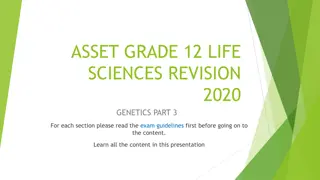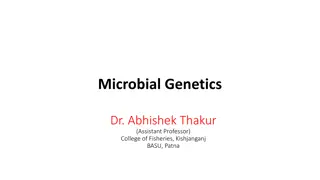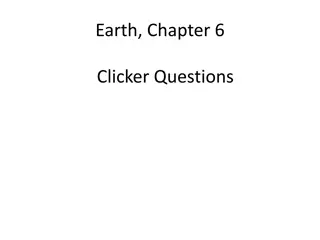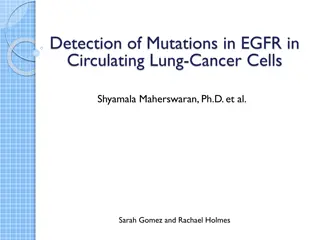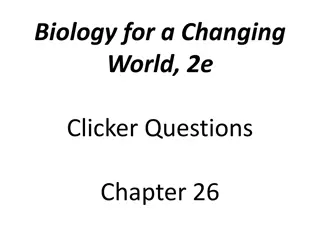Understanding Mutations in Biology: Clicker Questions Explained
Explore a series of clicker questions related to mutations in biology, covering topics such as the definition of mutations, their effects, inheritance patterns, and the impact on amino acid sequences. Gain insights into how mutations occur, their consequences, and their role in genetic processes.
Download Presentation

Please find below an Image/Link to download the presentation.
The content on the website is provided AS IS for your information and personal use only. It may not be sold, licensed, or shared on other websites without obtaining consent from the author. Download presentation by click this link. If you encounter any issues during the download, it is possible that the publisher has removed the file from their server.
E N D
Presentation Transcript
Biology for a Changing World, 2e Clicker Questions Chapter 10
A mutation is A. a toxin that accumulates in the body. B. a cancer-causing agent like tobacco smoke. C. an observable physical change in a person. D. a change in DNA sequence. E. the way you get super-powers.
Mutations are A. never beneficial. B. never fatal. C. often undetectable. D. usually cancer-causing. E. usually fatal.
If a gene becomes mutated, but it is non-lethal and it is passed to offspring, it will then be a(n) A. allele. B. cancer. C. carcinogen. D. mutagen. E. gamete.
A mutation in a ______ cell will not be passed onto offspring, whereas a mutation in a ______ cell might be passed to offspring. A. cancer; somatic B. cancer; germ C. skin; somatic D. somatic; germ E. germ; cancer
A mutation in a ______ cell will not be passed onto offspring, whereas a mutation in a ______ cell might be passed to offspring. A. cancer; somatic B. cancer; germ C. skin; somatic D. somatic; germ E. germ; cancer
What amino acid sequence is encoded by the mRNA shown below? A. Start Pro Ser Asp Gly B. Met Pro Gly- Ser - Gly C. Pro Ser Asp - Gly D. Met Pro Ser Asp Gly E. None of the above.
How would the amino acid sequence change if the nucleotide denoted by the arrow was changed to A? A. The amino acid sequence would not change. B. The sequence would end after two amino acids. C. The sequence would be the same except that this one amino acid would be missing. D. The amino acid at the third position would be methionine (Met). E. All the following amino acids after the third position would be changed.
A normally functioning gene that regulates the cell cycle by promoting cell division is most likely to be a A. proto-oncogene. B. oncogene. C. carcino-gene. D. muta-gene. E. tumor suppressor.
Mutations in p53, a tumor suppressor, are often cancer-causing. p53 normally functions by A. inducing apoptosis. B. promoting cell division. C. inducing tumor growth. D. repressing proto-oncogenes. E. None of the above.
Which of the following is NOT considered a mutagen? A. alcohol B. char (blackened bits) grilled meats C. UV light D. cigarette smoke E. All of the above are mutagens.
Put the following steps in the progression of cancer in order from earliest to latest: 1. UV light mutates p53 gene. 2. Cells accumulate multiple mutations and spread to tissues throughout the body. 3. Mutation in a proto-oncogene is inherited. A. 3, 2, 1 B. 2, 1, 3 C. 1, 2, 3 D. 2, 3, 1 E. 3, 1, 2
Why do BRCA1 and BRCA2 mutations increase the risk of cancer? A. These mutations cause cells to undergo apoptosis. B. These mutations prevent cells from undergoing mitosis. C. Mutations in these genes allow damaged cells to divide. D. These mutations cause DNA damage to occur. E. Both C and D.
Genetic disorders are more common for A. white, non-Hispanic, people. B. women. C. people who practice Judaism. D. isolated populations, regardless of race, ethnic origin, or gender. E. There is no correlation between ancestry and rates of genetic disorders.
Skin cancer is usually caused by mutations accumulating in skin cells. However, having parents that developed skin cancer increases your risk for developing it. Why is this? A. Skin cancer is caused by UV light. B. Skin cancer must not be caused by UV light. C. Cancer can be passed on to offspring. D. Parents can pass on mutations in their germ cells that increase skin cancer risk. E. Skin cancer is a mutagen.
A woman has a mutation in the BRCA1 gene, which is known to be associated with the development of breast cancer. This means A. nothing. B. that this woman cannot get breast cancer. C. that this woman will develop breast cancer. D. that this woman has inherited cancer from her parents. E. that this woman has a higher statistical likelihood of developing cancer.
Genetic disorders are more common within isolated populations because A. it is more likely that two people with the same rare allele will mate and produce offspring. B. isolated populations tend to have decreased genetic diversity. C. individuals within an isolated population tend to mate with other individuals from the same population. D. All of the above. E. None of the above.
Which of the following step might be considered as a special measure for reducing the risk of cancer for hereditary cancers? A. Wear sunscreen. B. Avoid tobacco. C. Maintain a healthy weight. D. Consider genetic counseling and testing. E. Avoid or reduce alcohol consumption.







